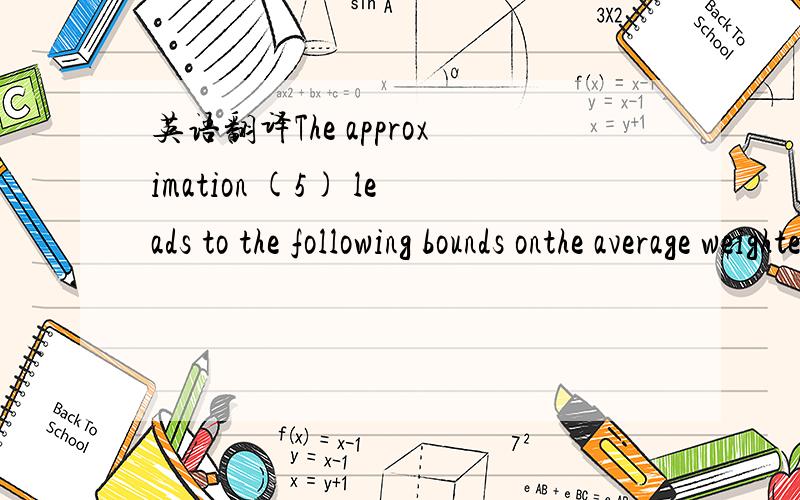英语翻译The approximation (5) leads to the following bounds onthe average weighted squared error:This upper bound is tight because it would be achieved fora spectrum Fm that is concentrated entirely on the worstcasefrequency.In light of this tigh
来源:学生作业帮助网 编辑:作业帮 时间:2024/04/25 16:04:21

英语翻译The approximation (5) leads to the following bounds onthe average weighted squared error:This upper bound is tight because it would be achieved fora spectrum Fm that is concentrated entirely on the worstcasefrequency.In light of this tigh
英语翻译
The approximation (5) leads to the following bounds on
the average weighted squared error:
This upper bound is tight because it would be achieved for
a spectrum Fm that is concentrated entirely on the worstcase
frequency.In light of this tight bound,it is desirable
to design the scaling factors s and the interpolation coefficients
u(x) to minimize the worst-case error by the following
min–max criterion (cf.[4,Eq.(10)]):
Finding u(x) by minimizing (15) is simply a weighted
least-squares problem that is linear in u.Solving that minimization
directly leads to complex expressions,e.g.[1,Eq.
(7)] that perhaps shroud the nature of the interpolator.For
more insight,we rewrite the error as follows (cf.[4,Eq.
(14)]):
英语翻译The approximation (5) leads to the following bounds onthe average weighted squared error:This upper bound is tight because it would be achieved fora spectrum Fm that is concentrated entirely on the worstcasefrequency.In light of this tigh
(5)式的近似导致了以下对加权平均平方误差的范围:这个上限是严密的,因为它将实现一个光谱调频,这是完全基于最坏情况下的频率.鉴于这种严密的范围,人们希望设计的缩放因子和插值系数u(x)通过以下最小-最大准则–最小化误差(参见[ 4,方程(10)])得到:通过最小化(15)式找到U(x),这是一个简单的加权最小二乘问题,在u(x)中这个问题是线性的.最小化直接导致复杂的表达式,例如[ 1,方程(7)],也许覆盖了内插的性质.为了更深入地了解,我们改写误差如下(参见[ 4,方程(14)]):
The approximation (5) leads to the following bounds on
the average weighted squared error:
This upper bound is tight because it would be achieved for
a spectrum Fm that is concentrated ent...
全部展开
The approximation (5) leads to the following bounds on
the average weighted squared error:
This upper bound is tight because it would be achieved for
a spectrum Fm that is concentrated entirely on the worstcase
frequency. In light of this tight bound, it is desirable
to design the scaling factors s and the interpolation coefficients
u(x) to minimize the worst-case error by the following
min–max criterion (cf. [4, Eq. (10)]):
Finding u(x) by minimizing (15) is simply a weighted
least-squares problem that is linear in u. Solving that minimization
directly leads to complex expressions, e.g. [1, Eq.
(7)] that perhaps shroud the nature of the interpolator. For
more insight, we rewrite the error as follows (cf. [4, Eq.
(14)]):
意思:这个近似(5)导致下面的界限
平均加权平方误差:
这个上界很紧,因为它将会实现的
一个光谱调频是集中在worstcase完全
频率。鉴于这种紧密的束缚,它是可取的
设计了比例因子的年代和插值系数
u(x)最小化最坏的错误由以下
分钟马克斯准则(cf。[4,Eq。(10))):
寻找u(x)通过最小化(15)是一个简单的加权
最小二乘计算
收起